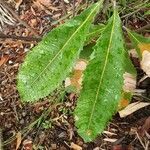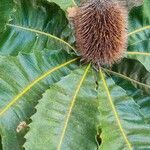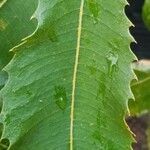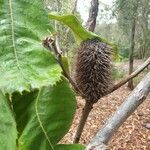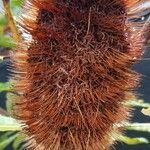Shrub to 3 m tall, often straggly, with lignotuber. Bark smooth. Stems rusty-tomentose, becoming glabrous and grey. Leaves alternate; petiole 10-20 mm long; lamina obovate or elliptic, 12-30 cm long, 5-17 cm wide, truncate; margins slightly recurved, shortly serrate with many small teeth; upper surface tomentose, glabrescent; lower surface tomentose, with veins glabrescent. Inflorescence 10-17 cm long; involucral bracts 3-8 mm long, tomentose, persistent. Flowers crowded, metallic green in bud, becoming golden when open; style pale yellow. Perianth 22-26 mm long including limb of 3-4 mm, closely pubescent outside, glabrous inside. Pistil slender, straight, 28-33 mm long, glabrous; pollen presenter narrowly ovoid, 0.75 mm long. Old flowers persistent. Follicles up to c. 100 or more, narrowly elliptic, 10-16 mm long, 5-8 mm high, 4-6 mm wide; valves semi-elliptic, smooth, tomentose. Seed obovate, 15-20 mm long; seed body triangular, oblique, 10-11 mm long, 4-5 mm wide, smooth to slightly rugose.
More
A spreading shrub. It grows 1-2 m tall. The leave are alternate and narrowly oval. They can be 40 cm long. There are teeth along the edge. They are velvety white underneath. The flowers are in large spikes up to 17 cm long and 5-6 cm wide. They are a metallic green with pinkish styles in the bud stage. They become golden brown. The fruit is a follicle with 100 fruit.
